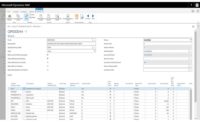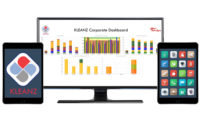Every facility needs a food safety plan, and that includes food safety software related to traceability. This software will come in handy whenever a company needs to trace a certain ingredient or product, due to recalls or other reasons.
“A food safety plan, like any other plan, is only as good as its implementation and proof of compliance. Wherefour helps users facilitate and document compliance with their plans and requirements for HAACP, HARPC and other regulatory and auditing bodies,” says Matt Brown, CEO, Wherefour, Petaluma, CA. “Instructions in bills of material or the production module of Wherefour can include GMP process instructions for sanitation, to make it easy for users to follow correct procedure during each batch. A permanent record of every step is kept in an unalterable log for verification and shows any corrective actions taken if necessary,” he says.
Wherefour also has a variety of inventory safeguards that minimize or prevent sanitation issues relating to allergen control by allowing only raw materials protected from cross-contamination to be selected for production. Likewise, inventory can be quarantined while waiting for QA test results, Brown adds. “Some users do in-process sampling for QA testing throughout production as part of their monitoring process and to verify the effectiveness of their sanitation controls. Wherefour allows these QA test parameters to be customized to capture whatever data is required.”
An important part of food safety is being able to find foreign objects in food products. Yuegang Zhao, CCO, KPM Analytics, Westborough, MA, says that the company’s vision inspection systems use a series of high-speed cameras and imaging software to detect and measure food products as they move along a conveyor belt. “Custom software and measurement algorithms can determine the size, shape, color or composite measurement of any object and convert this into standard units for quality control. For food safety, the system has the capability to detect foreign objects on food products. This includes items such as metal or plastic which can unfortunately make their way onto the production line,” he says.
“Depending on applications, foreign objects can be detected using color cameras or hyperspectral cameras, which take multiple images at different wavelengths,” says Zhao. “Some foreign objects may appear in similar colors as the food products, but will show much higher contrast under different wavelength of source light.”
Eric Weisbrod, vice president, product management, InfinityQS, Fairfax, VA, says that all of the company’s software solutions directly address the needs of all food manufacturers as well as snack food and bakery operations. “Our software products are used not just for process control reasons, but also to directly support your HAACP, GMP, SSOP, sanitation, and other food-specific data collection requirements,” he notes.
There are several key benefits that this industry can enjoy with a centralized quality system, including data-driven insights, data accessibility, and data assurance, Weisbrod says. “Every organization is required to collect different types of data for process improvement, compliance, customer requirements, etc. This data is already being collected, so it should be turned into actionable intelligence by having tools to aggregate and roll up data so it can be meaningfully analyzed and, most importantly, acted upon.”
Data accessibility is directly applicable to audits and traceability for all kinds of checks (HACCP, GMP, SSOP, etc.), says Weisbrod. “Simply having the data available in a centralized, electronic system means results are immediately available to answer internal questions, customer requests, and audit requests. This is vastly superior to using paper and pencil, or a collection of scattered spreadsheets or local applications.”
Weisbrod says that manufacturers have similar concerns regarding their quality checks:
-
Have the appropriate data collections been performed?
-
Are the collected values acceptable?
-
Are the appropriate actions being taken?
“Based on the first two items, the next question to answer is if the right actions are being taken if a check is late/missed, a value is out of specification, etc. Having the ability to require corrective actions, assignable causes, comments, etc., helps ensure that employees are taking the correct actions and provides visibility to know they are being done. Further, organizations now have the ability to analyze these actions and understand how to prevent future issues,” says Weisbrod.
Eric Garr, regional sales manager, Fortress Technology, Toronto, comments that Fortress recently unveiled a new suite of easy to implement industry compliant data capture and connectivity tools. Adding to the company’s existing Contact Reporter and Contact Manager turnkey package—included as standard on all Stealth and Interceptor metal detector models—bakeries and global snack manufacturers now have a new option to automate the collection and collation of data over their network using Contact 4.0. Additional options include Industry 4.0-ready data retrieval communication adapters.
“Contact 4.0 features a web-based interphase that lives on the network within the Contact 4.0 web appliance. This software interphases with all Fortress equipment, namely our new Raptor Checkweigher series. Contact Manager, which also automates data extraction, polling the metal detectors over a secure network connection and generating detailed reports, will only collect data from metal detectors. Contact 4.0 allows for grouping of systems throughout the factory and provides a high-level status that can be drilled down into for more detailed real time information for each group of systems,” he explains.
All these solutions have been designed to assist food manufacturers maintain compliance with all international food safety standards, including HACCP, BRC, and GFSI/SQF.
For bakeries and snack producers with existing data extraction and factory management software, Fortress launched two new Communication Adapter platforms, OPC/UA Adapter and Ethernet IP Adapter. These provide a seamless connection and communication aligned to industry standard protocols and pull real-time granular data into each customer’s internal reporting system, Garr says.
Company: Wherefour
Website: https://amkinggroup.com
Sanitation Snapshot: Wherefour takes a lot of the heavy-lifting out of record-keeping and retrieval with true cloud-based document storage that gives easy access to compliance or food safety paperwork, says Brown. “Any kind of documentation can be uploaded from handwritten notes to photos for logging and tracking sanitation procedures and critical control points. Optional alerts can be set for when documents need to be refreshed or revisited.”
Users can upload sanitation logs and tag the information to specific records within the system and even associate them with documentation for HAACP, BRC, etc. Wherefour can also do this on the fly within production and for purchase orders.
“One of the biggest advantages of having all food safety materials in one place is the ability to search or recall information for audit, inspection or mock recall scenarios. All information in Wherefour is updated in real time with full traceability in a variety of reporting formats including by ingredients, production lots and shipments,” Brown notes.
Companies can use mobile devices to take photos and upload to the platform, or use the camera on a mobile device as a scanner for searching for inventory.
New software solutions:
-
QA capabilities that allows users to define custom QA tests
-
Custom fields for defining things like CBD levels in a product
-
Users can put inventory “on hold” for specific orders, if additional compliance or QA checks need to be performed
-
For Shopify companies, Wherefour has a new integration that intakes Shopify orders automatically so they can be produced and fulfilled on its platform, with full material traceability
Company: KPM Analytics
Website: www.kpmanalytics.com
Sanitation Snapshot: The Sightline and EyePro brands of KPM Analytics provide systems to food manufactures for final inspection before packaging, mid-process inspection for better process control, and off-line testing for random sample quality inspection. By working with customers closely new features and solutions are developed continuously, says Zhao.
“One major development that is worth mentioning—hyperspectral imaging. Hyperspectral imaging is using special camera and lighting fixtures so that multiple images can be acquired in different wavelengths of light,” says Zhao. “Similar to color cameras, which capture images simultaneously in red, green, and blue color, hyperspectral imaging can capture up to a few hundreds of pictures at the same time at different wavelength in the near infrared (NIR) range. NIR range is commonly used in spectrum analyzers for food analysis as moisture, fat, protein, sugar, etc. all have very strong absorption behavior in this range. By taking multiple pictures at different wavelengths and applying a calibration algorithm, we can see the moisture profile of a piece of a cookie, or a piece of plastic or wood chip on top of a chicken nugget or a pizza. This significantly advances the use of vision inspection for food safety applications.”
New software solutions:
-
Hyperspectral imaging
-
Further improving process control—i.e., controlling oven temperatures based on visual inspection of product
-
Ability to view crumb structure
-
Visual displays that can be installed directly into the factory so operators can stay informed in real time of product quality
Company: InfinityQS
Website: www.infinityqs.com
Sanitation Snapshot: Weisbrod says that InfinityQS’s Enact product has quarterly updates, so it is always being enhanced. Some of its recent and upcoming enhancements include a Lot Report—a summary of individual production lots to provide a snapshot of all relevant measurements taken—as well as a Lot Genealogy Report, which is traceability of production lots from raw materials through finished goods.
Other new features include a Compliance Summary Report, a summary of timed data collection performance that rolls up to each site and can be configured to automatically show the results that align with your data collection goals (e.g., targets for on-time checks).
Another feature is its KPI Publishing, where businesses can publish results by day, shift, and lot to be used by external systems (e.g., business intelligence, custom dashboard solutions, etc.) to provide a cohesive view of information from all shop floor systems.
New software solutions:
-
Enhancements to Enact product
-
Improving efficiency and effectiveness
-
Focusing on exceptions
-
Using automatic data aggregations to use individual measurements to see larger trends, prioritize improvement efforts
Company: Fortress Technology
Website: www.fortresstechnology.com
Sanitation Snapshot: The Industry 4.0 range of solutions is the newest software addition from Fortress.
Additionally, at PACK EXPO 2021, Fortress will debut two Raptor Checkweighing systems—a single frame standalone checkweigher and an XL caseweighing system for ingredient and bulk applications, such as flour sacks, weighing up to 25 kg. A heavy-duty 50 kg version is also available. Operating as a standalone product feed and packing weighing unit, the Raptor Checkweigher’s modular electronics suite allows for full integration with a Fortress metal detector to create a high-precision combination system.
For bakeries and free-from manufacturers especially, the Raptor Checkweigher can help to offset inflation and food price hikes—notably, rising grain prices.
New software solutions:
-
Industry 4.0 range of solutions
-
Two new Raptor checkweighers
-
Halo Automatic Testing
-
AutoPhase software










